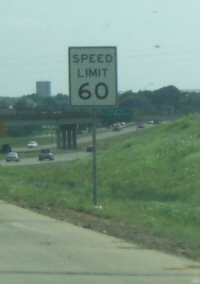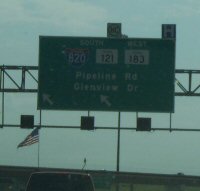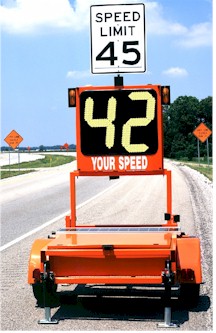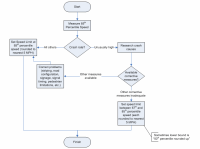For my ENCE 7392 (Urban Transportation Planning) class I made a flowchart of the current procedure used for speed zoning in Texas. This chart has three sections:
Category: Traffic Safety
Arbitrary Speed Limit Policy in North Texas
Goofball Speed Limits on TX 121
Outside I-820:

Crossing I-820:

Inside the loop!

Normally you would expect lower limits as you approach major areas of a city. Thanks to environmental speed limits, the speed limit on the outlying stretch of TX 121 is arbitrarily restrained at 60 MPH.
In the Dallas/Fort Worth area, all roadways with a 70 and 65 MPH speed limit before Sept. 1, 2001 were remarked with 65 and 60 MPH speed limits, respectively. This was a ballyhooed part of a massive smog reduction plan.
This speed reduction measure may bring the area 0.1% closer to its smog goal with “may” being the operative word. Yes, that’s one tenth of a percent! If you consider the paradoxical effects of low speed limits, mainly less respect for the entire body of traffic laws, these lower speed limits may have actually increased emissions!
Anyway, the 2001 speed limit reductions were carefully defined road by road. (Map of actual roadway segments with reduced limits.) In 2003, the Texas Legislature prospectively banned environmental speed limit reductions. This means that current reductions can stay, but no future reductions may happen.
Now the DFW area is left with a weird patchwork of speed limit reductions. Some highways have reduced speed limits and some don’t. But first a little background.
While it is not published anywhere, TxDOT’s de facto standard in major urban areas is to use 70 MPH speed limits until you reach the outer loop (e.g., Sam Houston Tollway), 65 MPH limits between the outer loop and the inner loop (e.g., I-610), 60 MPH limits between downtown and the inner loop, and sometimes 55 or 50 MPH limits on certain downtown freeways with many exits (e.g., I-30 near downtown Dallas). This is an arbitrary practice that seems to be in place mainly due to communal reinforcement and “monkey see monkey do.” In all my driving experience in Texas the only exception to this rule I have ever experienced is the 65 MPH limit that used to be on US-59 southwest of Houston between the Buffalo Speedway and Beltway 8.
With environmental speed limits, the new arbitrary standard is that once you cross a county line nearest to about 50 miles from downtown, the speed limit goes from 70 to 65, and then to 60 once you cross the outer loop. Speed limits then stagnated at 60 for miles and miles until they dropped once again near downtown.
Now in Ft. Worth, there is a major exception to the rule. By the PDF map you can see that Texas 121 between I-35W and I-820 in Ft. Worth was not subject to the environmental speed limit reduction. This is because its speed limit on Sept. 1, 2001 was 60 MPH or lower. Since then the TxDOT has apparently re-speed zoned that roadway and found that a 65 MPH limit is more appropriate, so this entire segment now has a 65 MPH speed limit.
TxDOT’s Dallas District is in the process of reviewing all Dallas-area roadways. Since no inner-loop speed limit is subject to speed limit reductions, it is very possible that the Dallas area could experience a patchwork of highly inconsistent speed limit policy where some freeways get higher limits the closer you get to downtown Dallas.
I don’t agree with the arbitrarily low speed limits that end up posted on most highways, but I also don’t agree with inconsistent speed limit policy. One standard should be followed on all roadways, and it should not be hamstrung by the political will of the day.
How can this be fixed? Three easy ways:
- Eliminate all environmental speed limit reductions. They don’t work, and continuing to use them only means that the DFW area’s regional emissions reduction scheme relies on a paper trick that won’t reduce smog.
- Eliminate all legislatively-imposed speed limit caps. Speed limits should always be set by commonly accepted engineering methods. There is no reason for the legislature to arbitrarily declare that these methods are broken if they recommend limits higher than some number picked out of a hat.
- Tighten up on leeway in speed zoning standards. Current TxDOT speed zoning standards allow huge engineer discretion to lower the posted limit below what a speed survey recommends. In theory this leeway is only supposed to be used to correct speed limits in the face of unusual safety problems, but in practice it is used virtually everywhere to justify needlessly low limits.
Slowpoke vs. Enjoy the Ride
“Slow down, take it easy, and enjoy the ride” is dumb and paradoxical. This statement is a sugar-coated way of suggesting that slothful driving makes a trip more enjoyable. Strictly from a transportation perspective, nothing could be more wrong.
The bulk of vacation scenery is featureless cornfields, road kill skunks, and billboards. The faster one blazes through this, the more enjoyable a vacation is.
A small portion of driving scenery is scenic features like wide vistas, distant mountains, and approaching storms. Whether you are doing 55 MPH or 155 MPH doesn’t affect your enjoyment of these distant features. Yeah, so you may only have 15 minutes to enjoy a mountain view instead of 30, but who cares? After the first few seconds of the view, you have absorbed about all meaningful information you are going to get. Compared to “going there and doing it,” looking at something through the window is excruciatingly trivial. Summiting a 12,441 foot mountain peak is an amazing experience; looking at it through a car window is not much better than staring at pictures on your computer. Slothful speeds only starve you of time for stops at meaningful destinations. More time to savor the dead skunks is better than time with grandma, right?
Some people think that fast speed has a direct correlation to a poorly planned vacation, and that by driving slowly the vacation will magically be more enjoyable. The truth is that again, by squeezing time out for meaningful activities, slow travel speeds worsen the quality of any vacation, well planned or not. A better approach is scheduling plenty of stops, be realistic with travel times, and, most importantly, stop cheating yourself and your family with short vacations!
The two easiest ways to maximize enjoyment is to minimize time in the car and maximize meaningful stops. In other words, drive as fast as you are comfortable, and stop often.
Corrupt Illinois speed zoning practices
 A member of Illinois law enforcement who specializes in traffic issues told me that Illinois uses speed display trailers for speed zoning studies.
A member of Illinois law enforcement who specializes in traffic issues told me that Illinois uses speed display trailers for speed zoning studies.
A little background: the commonly accepted way to set speed limits is to measure the speed of passenger vehicles in a way that is not apparent to motorists. From that speed survey a traffic engineer sets a limit that legalizes most drivers and criminalizes only the fastest, most dangerous drivers.
Speed trailers bias the speed of traffic so that it conforms to the currently posted limit. For example, you will probably slow down if the speed limit sign says 50 but “YOUR SPEED” says 58.
This practice reinforces the currently posted speed limit even where properly run speed zoning studies would have required a higher limit.
What does this mean for the everyday motorist? Ever lower speed limits, causing wider gaps between the fastest and slower drivers, more tickets, and more safety problems.
In a practical sense, the commonly accepted speed zoning practice is usually overridden by arbitrary laws or politics. On nearly every road in the U.S., speed limits are already set so low that nearly everyone is a lawbreaker. Short circuiting speed zoning so that it just reinforces the currently posted limit is a shameful, corrupt, revenue-enhancing practice.
Illinois drivers should be infuriated.
I-35
Friday was the first time I traveled Interstate 35 between Dallas and Austin, in daylight, in at least 10 years. The normal traffic on I-35 was like I-45 on a busy traveling holiday.
That road’s total right of way seems to be relatively narrow. There is usually only a tiny median between the northbound and southbound inside shoulders. This means that a single careless error can hurdle your 80 MPH car into 80 MPH oncoming traffic. Let’s see, 80 MPH + 80 MPH = really nasty.
In part due to these minimal center medians, TxDOT is erecting stout center barriers on long stretches of I-35. Since most of this wall is new, you can clearly see every impact on it. On one multi-mile stretch I was amazed to see several tire tracks clearly veering into the wall and then bouncing back off. Most of the time the errant vehicle appears to settle in the left shoulder. Sometimes the errant vehicle hits the wall and careens the other way, crossing both lanes and probably running off the right shoulder. Very often the tire marks were of an axle with double wheels on both sides, like with a 18 wheeler or a dually truck.
This barrier upgrade makes I-35 generally superior to German Autobahns. You gotta wonder why the Texas Legislature still arbitrarily caps speed limits at 70 MPH?
At least two small towns had interesting interchanges with I-35 and their main road. Basically I-35 was an underpass in a small canyon that was only wide enough for 2 lanes each way. It looks like this 1950s shot of I-35 in Austin. This kind of interchange is at home on an older US highway, not on the busiest interstate corridor in Texas! When it comes time to widen the roadway, these cities may be in for a surprise.


